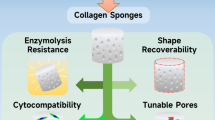Abstract
Collagen-based scaffolds are extensively used in biomaterials and tissue engineering applications. These scaffolds have shown great biocompatibility and versatility, but their relatively low mechanical properties may limit use in orthopaedic load-bearing applications. Moreover, terminal sterilization with gamma irradiation, as is commonly performed with commercial devices, presents concerns over structural integrity and enzymatic stability. Therefore, the goal of this study was to test the hypothesis that EDC/NHS cross-linking (10 mM/5 mM) can protect collagen-hyaluronan sponges from the damaging effects of gamma irradiation. Specifically, we evaluated compressive and tensile mechanical properties, enzymatic stability, porosity and pore size, and swelling ratio. Ultimate tensile strength and elastic modulus exhibited increases (168.5 and 245.8%, respectively) following irradiation, and exhibited over tenfold increases (1049.2 and 1270.6%, respectively) following cross-linking. Irradiation affected pore size (38.4% decrease), but cross-linking prior to irradiation resulted in only a 17.8% decrease. Cross-linking also showed an offsetting effect on the equilibrium modulus, enzymatic stability, and swelling ratio of sponges. These results suggest that carbodiimide cross-linking of collagen-hyaluronan sponges can mitigate the structural damage typically experienced during gamma irradiation, warranting their use in tissue engineering applications.







Similar content being viewed by others
References
Merriam AR, Patel JM, Culp BM, Gatt Jr. CJ, Dunn MG. Successful total meniscus reconstruction using a novel fiber-reinforced scaffold: a 16 and 32-week study in an ovine model. Am J Sports Med. 2015;43:2528–37. https://doi.org/10.1177/0363546515595065.
Geiger M, Li RH, Friess W. Collagen sponges for bone regeneration with rhBMP-2. Adv Drug Deliv Rev. 2003;55:1613–29.
Glowacki J, Mizuno S. Collagen scaffolds for tissue engineering. Biopolymers. 2008;89:338–44. https://doi.org/10.1002/bip.20871.
Ghodbane SA, Dunn MG. Physical and mechanical properties of cross-linked type I collagen scaffolds derived from bovine, porcine, and ovine tendons. J Biomed Mater Res A. 2016;104:2685–92. https://doi.org/10.1002/jbm.a.35813.
Ma B, Wang X, Wu C, Chang J. Crosslinking strategies for preparation of extracellular matrix-derived cardiovascular scaffolds. Regen Biomater. 2014;1:81–9. https://doi.org/10.1093/rb/rbu009.
Lin Y-C, Tan F-j, Marra KG, Jan S-S, Liu D-C. Synthesis and characterization of collagen/hyaluronan/chitosan composite sponges for potential biomedical applications. Acta Biomater. 2009;5:2591–600. https://doi.org/10.1016/j.actbio.2009.03.038.
Xu C, Lu W, Bian S, Liang J, Fan Y, Zhang X. Porous collagen scaffold reinforced with surfaced activated PLLA nanoparticles. Sci World J. 2012;2012:695137. https://doi.org/10.1100/2012/695137.
Chan EC, Kuo S-M, Kong AM, Morrison WA, Dusting GJ, Mitchell GM, et al. Three dimensional collagen scaffold promotes intrinsic vascularisation for tissue engineering applications. PLoS ONE. 2016;11:e0149799. https://doi.org/10.1371/journal.pone.0149799.
Ohyabu Y, Adegawa T, Yoshioka T, Ikoma T, Uemura T, Tanaka J. Cartilage regeneration using a porous scaffold, a collagen sponge incorporating a hydroxyapatite/chondroitinsulfate composite. Mater Sci Eng B. 2010;173:204–7. https://doi.org/10.1016/j.mseb.2009.12.008.
Liang W-H, Kienitz BL, Penick KJ, Welter JF, Zawodzinski TA, Baskaran H. Concentrated collagen-chondroitin sulfate scaffolds for tissue engineering applications. J Biomed Mater Res A. 2010;94:1050–60. https://doi.org/10.1002/jbm.a.32774.
Greene JJ, Sidle DM. The hyaluronic acid fillers: current understanding of the tissue device interface. Facial Plast Surg Clin North Am. 2015;23:423–32. https://doi.org/10.1016/j.fsc.2015.07.002.
Collins MN, Birkinshaw C. Hyaluronic acid-based scaffolds for tissue engineering—a review. Carbohydr Polym. 2013;92:1262–79. https://doi.org/10.1016/j.carbpol.2012.10.028.
Kreger ST, Voytik-Harbin SL. Hyaluronan concentration within a 3D collagen matrix modulates matrix viscoelasticity, but not fibroblast response. Matrix Biol. 2009;28:336–46. https://doi.org/10.1016/j.matbio.2009.05.001.
Murray MM, Spindler KP, Abreu E, Muller JA, Nedder A, Kelly M, et al. Collagen-platelet rich plasma hydrogel enhances primary repair of the porcine anterior cruciate ligament. J Orthop Res. 2007;25:81–91. https://doi.org/10.1002/jor.20282.
Hesse E, Hefferan TE, Tarara JE, Haasper C, Meller R, Krettek C, et al. Collagen type I hydrogel allows migration, proliferation and osteogenic differentiation of rat bone marrow stromal cells. J Biomed Mater Res A. 2010;94:442–9. https://doi.org/10.1002/jbm.a.32696.
He X, Kawazoe N, Chen G. Preparation of cylinder-shaped porous sponges of poly(L-lactic acid), poly(DL-lactic-co-glycolic acid), and poly(ε-caprolactone). Biomed Res Int. 2014;2014:106082. https://doi.org/10.1155/2014/106082.
Matuska AM, McFetridge PS. The effect of terminal sterilization on structural and biophysical properties of a decellularized collagen-based scaffold; implications for stem cell adhesion. J Biomed Mater Res B Appl Biomater. 2015;103:397–406. https://doi.org/10.1002/jbm.b.33213.
Noah EM, Chen J, Jiao X, Heschel I, Pallua N. Impact of sterilization on the porous design and cell behavior in collagen sponges prepared for tissue engineering. Biomaterials. 2002;23:2855–61.
Davidenko N, Schuster CF, Bax DV, Raynal N, Farndale RW, Best SM, et al. Control of crosslinking for tailoring collagen-based scaffolds stability and mechanics. Acta Biomater. 2015;25:131–42. https://doi.org/10.1016/j.actbio.2015.07.034.
Faraj KA, Brouwer KM, Geutjes PJ, Versteeg EM, Wismans RG, Deprest JA, et al. The effect of ethylene oxide sterilisation, beta irradiation and gamma irradiation on collagen fibril-based scaffolds. Tissue Eng Regen Med. 2011;8:460–70.
Awang MA, Firdaus MA, Busra MB, Chowdhury SR, Fadilah NR, Wan Hamirul WK, et al. Cytotoxic evaluation of biomechanically improved crosslinked ovine collagen on human dermal fibroblasts. Biomed Mater Eng. 2014;24:1715–24. https://doi.org/10.3233/BME-140983.
Ruijgrok JM, de Wijn JR, Boon ME. Glutaraldehyde crosslinking of collagen: Effects of time, temperature, concentration and presoaking as measured by shrinkage temperature. Clin Mater. 1994;17:23–7. https://doi.org/10.1016/0267-6605(94)90044-2.
McKegney M, Taggart I, Grant MH. The influence of crosslinking agents and diamines on the pore size, morphology and the biological stability of collagen sponges and their effect on cell penetration through the sponge matrix. J Mater Sci Mater Med. 2001;12:833–44.
Gough JE, Scotchford CA, Downes S. Cytotoxicity of glutaraldehyde crosslinked collagen/poly(vinyl alcohol) films is by the mechanism of apoptosis. J Biomed Mater Res. 2002;61:121–30. https://doi.org/10.1002/jbm.10145.
Ahmad Z, Shepherd JH, Shepherd DV, Ghose S, Kew SJ, Cameron RE, et al. Effect of 1-ethyl-3-(3-dimethylaminopropyl) carbodiimide and N-hydroxysuccinimide concentrations on the mechanical and biological characteristics of cross-linked collagen fibres for tendon repair. Regen Biomater. 2015;2:77–85. https://doi.org/10.1093/rb/rbv005.
Seto A, Gatt Jr. CJ, Dunn MG. Radioprotection of tendon tissue via crosslinking and free radical scavenging. Clin Orthop Relat Res. 2008;466:1788–95. https://doi.org/10.1007/s11999-008-0301-9.
Oloyede A, Broom ND. A physical model for the time-dependent deformation of articular cartilage. Connect Tissue Res. 1993;29:251–61.
Mow VC, Kuei SC, Lai WM, Armstrong CG. Biphasic creep and stress relaxation of articular cartilage in compression? Theory and experiments. J Biomech Eng. 1980;102:73–84.
Gibson LJ, Ashby MF. Cellular solids: structure and properties. The structure of cellular solids, Cambridge University Press, Cambridge, UK. 1999;43–7.
O’Brien FJ, Harley BA, Yannas IV, Gibson L. Influence of freezing rate on pore structure in freeze-dried collagen-GAG scaffolds. Biomaterials. 2004;25:1077–86.
Patel JM, Merriam AR, Culp BM, Gatt Jr. CJ, Dunn MG. One-year outcomes of total meniscus reconstruction using a novel fiber-reinforced scaffold in an ovine model. Am J Sports Med. 2016;44:898–907. https://doi.org/10.1177/0363546515624913.
Ran J, Hu Y, Le H, Chen Y, Zheng Z, Chen X, et al. Ectopic tissue engineered ligament with silk collagen scaffold for ACL regeneration: a preliminary study. Acta Biomater. 2017. https://doi.org/10.1016/j.actbio.2017.02.027.
Tamaddon M, Burrows M, Ferreira SA, Dazzi F, Apperley JF, Bradshaw A, et al. Monomeric, porous type II collagen scaffolds promote chondrogenic differentiation of human bone marrow mesenchymal stem cells in vitro. Sci Rep. 2017;7:43519. https://doi.org/10.1038/srep43519.
Powell HM, Boyce ST. EDC cross-linking improves skin substitute strength and stability. Biomaterials. 2006;27:5821–7. https://doi.org/10.1016/j.biomaterials.2006.07.030.
Mazor E, Zilberman M. Effect of gamma-irradiation sterilization on the physical and mechanical properties of a hybrid wound dressing. Polym Adv Technol. 2017;28:41–52. https://doi.org/10.1002/pat.3854.
Deyne PD, Haut RC. Some effects of gamma irradiation on patellar tendon allografts. Connect Tissue Res. 1991;27:51–62. https://doi.org/10.3109/03008209109006994.
Depalle B, Qin Z, Shefelbine SJ, Buehler MJ. Influence of cross-link structure, density and mechanical properties in the mesoscale deformation mechanisms of collagen fibrils. J Mech Behav Biomed Mater. 2015;52:1–13. https://doi.org/10.1016/j.jmbbm.2014.07.008.
Wang H-M, Chou Y-T, Wen Z-H, Wang Z-R, Chen C-H, Ho M-L. Novel biodegradable porous scaffold applied to skin regeneration. PLoS ONE. 2013;8:e56330. https://doi.org/10.1371/journal.pone.0056330.
Perez-Puyana V, Romero A, Guerrero A. Influence of collagen concentration and glutaraldehyde on collagen-based scaffold properties. J Biomed Mater Res A. 2016;104:1462–8. https://doi.org/10.1002/jbm.a.35671.
Tyan YC, Liao JD, Lin SP, Chen CC. The study of the sterilization effect of gamma ray irradiation of immobilized collagen polypropylene nonwoven fabric surfaces. J Biomed Mater Res A. 2003;67:1033–43. https://doi.org/10.1002/jbm.a.10024.
Acknowledgements
The authors thank the Orthopaedic Research Laboratory at Rutgers Biomedical and Health Sciences for their assistance in completing this study. They also thank Sukanya Murali for performing the SEM processing and imaging. This study was funded, in part, by the Department of Orthopaedic Surgery discretionary fund.
Author information
Authors and Affiliations
Corresponding authors
Ethics declarations
Conflict of interest
J.M.P. serves as a consultant for NovoPedics, Inc. M.G.D serves as interim secretary and treasurer and owns stock inNovoPedics Inc. The remaining authors declare that they have no conflict of interest.
Rights and permissions
About this article
Cite this article
Patel, J.M., Jackson, R.C., Schneider, G.L. et al. Carbodiimide cross-linking counteracts the detrimental effects of gamma irradiation on the physical properties of collagen-hyaluronan sponges. J Mater Sci: Mater Med 29, 75 (2018). https://doi.org/10.1007/s10856-018-6056-2
Received:
Accepted:
Published:
DOI: https://doi.org/10.1007/s10856-018-6056-2




